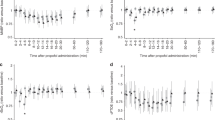Abstract
Purpose
Remimazolam is a new ultra-short-acting benzodiazepine with unknown effects on cerebral circulation. We measured total cerebral hemoglobin concentrations, which reflect cerebral blood volume (CBV), and cerebral oxygen saturation, using time-domain near-infrared spectroscopy, which can measure the absolute values of cerebral hemoglobin concentrations. We also measured cerebral blood flow velocity (CBFV) in the middle cerebral artery using transcranial Doppler as an indicator of cerebral blood flow (CBF). We did so to examine the effect of remimazolam on cerebral circulation in humans, as assessed CBV, CBF, and cerebral oxygen saturation.
Methods
This was a prospective, observational study. Fifteen patients without serious complications scheduled for general anesthesia were recruited. We measured total cerebral hemoglobin concentrations, CBFV, and cerebral oxygen saturation throughout the anesthetic induction course with remimazolam.
Results
Total cerebral hemoglobin concentrations did not change during the process (p = 0.51). In contrast, the mean CBFV was reduced by 11% (significant, p = 0.04). The drop in mean blood pressure following the induction of anesthesia was 17%; however, it was within the range of cerebrovascular autoregulation. Moreover, cerebral oxygen saturation increased by 4% (statistically significant, p < 0.01).
Conclusions
We found that anesthetic induction with remimazolam did not alter CBV and reduced CBF in uncomplicated patients.
Similar content being viewed by others
References
Todd MM, Weeks J. Comparative effects of propofol, pentobarbital, and isoflurane on cerebral blood flow and blood volume. J Neurosurg Anesthesiol. 1996;8(4):296–303.
Ohmae E, Ouchi Y, Oda M, Suzuki T, Nobesawa S, Kanno T, Yoshikawa E, Futatsubashi M, Ueda Y, Okada H, Yamashita Y. Cerebral hemodynamics evaluation by near-infrared time-resolved spectroscopy: correlation with simultaneous positron emission tomography measurements. Neuroimage. 2006;29(3):697–705.
Kanda Y. Investigation of the freely available easy-to-use software “EZR” for medical statistics. Bone Marrow Transplant. 2013;48(3):452–8.
Lange F, Tachtsidis I. Clinical brain monitoring with iime domain NIRS: A review and future perspectives. Appl Sci. 2019;9(8):1612.
Yamada Y, Suzuki H, Yamashita Y. Time-domain near-infrared spectroscopy and imaging: A review. Appl Sci. 2019;9:1127.
Aaslid R, Markwalder TM, Nornes H. Noninvasive transcranial Doppler ultrasound recording of flow velocity in basal cerebral arteries. J Neurosurg. 1982;57(6):769–74.
Serrador JM, Picot PA, Rutt BK, Shoemaker JK, Bondar RL. MRI measures of middle cerebral artery diameter in conscious humans during simulated orthostasis. Stroke. 2000;31(7):1672–8.
Bishop CC, Powell S, Rutt D, Browse NL. Transcranial Doppler measurement of middle cerebral artery blood flow velocity: A validation study. Stroke. 1986;17(5):913–5.
Ogawa Y, Iwasaki K, Aoki K, Gokan D, Hirose N, Kato J, Ogawa S. The different effects of midazolam and propofol sedation on dynamic cerebral autoregulation. Anesth Analg. 2010;111(5):1279–84.
Eng C, Lam AM, Mayberg TS, Lee C, Mathisen T. The influence of propofol with and without nitrous oxide on cerebral blood flow velocity and CO2 reactivity in humans. Anesthesiology. 1992;77(5):872–9.
Drummond JC. The lower limit of autoregulation: Time to revise our thinking? Anesthesiology. 1997;86(6):1431–3.
Kaisti KK, Långsjö JW, Aalto S, Oikonen V, Sipilä H, Teräs M, Hinkka S, Metsähonkala L, Scheinin H. Effects of sevoflurane, propofol, and adjunct nitrous oxide on regional cerebral blood flow, oxygen consumption, and blood volume in humans. Anesthesiology. 2003;99(3):603–13.
Ito H, Kanno I, Ibaraki M, Hatazawa J, Miura S. Changes in human cerebral blood flow and cerebral blood volume during hypercapnia and hypocapnia measured by positron emission tomography. J Cereb Blood Flow Metab. 2003;23(6):665–70.
Yagi Y, Yamamoto M, Saito H, Mori T, Morimoto Y, Oyasu T, Tachibana T, Ito YM. Changes of cerebral oxygenation in sequential Glenn and Fontan procedures in the same children. Pediatr Cardiol. 2017;38(6):1215–9.
Fujisaka SI, Ozaki T, Suzuki T, Kamada T, Kitazawa K, Nishizawa M, Takahashi A, Suzuki S. A clinical tissue oximeter using NIR time-resolved spectroscopy. Adv Exp Med Biol. 2016;876:427–33.
Kato S, Yoshitani K, Kubota Y, Inatomi Y, Ohnishi Y. Effect of posture and extracranial contamination on results of cerebral oximetry by near-infrared spectroscopy. J Anesth. 2017;31(1):103–10.
Fanning JP, Huth SF, Robba C, Grieve SM, Highton D. Advances in neuroimaging and monitoring to defend cerebral perfusion in noncardiac surgery. Anesthesiology. 2022;136(6):1015–38.
Masui K. Remimazolam besilate, a benzodiazepine, has been approved for general anesthesia!! J Anesth. 2020;34(4):479–82.
Acknowledgements
We would like to thank Editage (www.editage.com) for English language editing.
Author information
Authors and Affiliations
Contributions
Takashi Soejima contributed to design of study, data analysis, and preparation of the manuscript. Yuji Morimoto helped with designing of study, acquisition of the original data and drafting the manuscript. Koji Hoshino helped with drafting the manuscript. Kentaro Ueda, Sakae Hasegawa and Hiromitsu Motoe helped with acquisition of the original data. Kazufumi Okada and Yoichi M. Ito helped with statistical analyses. All authors read and approved the final manuscript.
Corresponding author
Ethics declarations
Conflict of interest
The authors declare that they have no conflicts of interest associated with this manuscript.
Additional information
Publisher's Note
Springer Nature remains neutral with regard to jurisdictional claims in published maps and institutional affiliations.
About this article
Cite this article
Soejima, T., Ueda, K., Hasegawa, S. et al. Change in cerebral circulation during the induction of anesthesia with remimazolam. J Anesth 37, 92–96 (2023). https://doi.org/10.1007/s00540-022-03135-7
Received:
Accepted:
Published:
Issue Date:
DOI: https://doi.org/10.1007/s00540-022-03135-7




